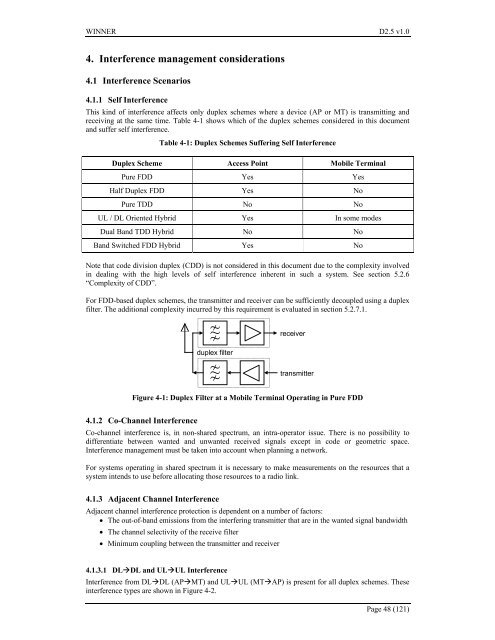IST-2003-507581 WINNER D2.5 v1.0 Duplex ... - Celtic-Plus
IST-2003-507581 WINNER D2.5 v1.0 Duplex ... - Celtic-Plus
IST-2003-507581 WINNER D2.5 v1.0 Duplex ... - Celtic-Plus
- No tags were found...
You also want an ePaper? Increase the reach of your titles
YUMPU automatically turns print PDFs into web optimized ePapers that Google loves.
<strong>WINNER</strong> <strong>D2.5</strong> <strong>v1.0</strong>4. Interference management considerations4.1 Interference Scenarios4.1.1 Self InterferenceThis kind of interference affects only duplex schemes where a device (AP or MT) is transmitting andreceiving at the same time. Table 4-1 shows which of the duplex schemes considered in this documentand suffer self interference.Table 4-1: <strong>Duplex</strong> Schemes Suffering Self Interference<strong>Duplex</strong> Scheme Access Point Mobile TerminalPure FDD Yes YesHalf <strong>Duplex</strong> FDD Yes NoPure TDD No NoUL / DL Oriented Hybrid Yes In some modesDual Band TDD Hybrid No NoBand Switched FDD Hybrid Yes NoNote that code division duplex (CDD) is not considered in this document due to the complexity involvedin dealing with the high levels of self interference inherent in such a system. See section 5.2.6“Complexity of CDD”.For FDD-based duplex schemes, the transmitter and receiver can be sufficiently decoupled using a duplexfilter. The additional complexity incurred by this requirement is evaluated in section 5.2.7.1.receiver~duplex filter~transmitterFigure 4-1: <strong>Duplex</strong> Filter at a Mobile Terminal Operating in Pure FDD4.1.2 Co-Channel InterferenceCo-channel interference is, in non-shared spectrum, an intra-operator issue. There is no possibility todifferentiate between wanted and unwanted received signals except in code or geometric space.Interference management must be taken into account when planning a network.For systems operating in shared spectrum it is necessary to make measurements on the resources that asystem intends to use before allocating those resources to a radio link.4.1.3 Adjacent Channel InterferenceAdjacent channel interference protection is dependent on a number of factors:• The out-of-band emissions from the interfering transmitter that are in the wanted signal bandwidth• The channel selectivity of the receive filter• Minimum coupling between the transmitter and receiver4.1.3.1 DLDL and ULUL InterferenceInterference from DLDL (APMT) and ULUL (MTAP) is present for all duplex schemes. Theseinterference types are shown in Figure 4-2.Page 48 (121)
















